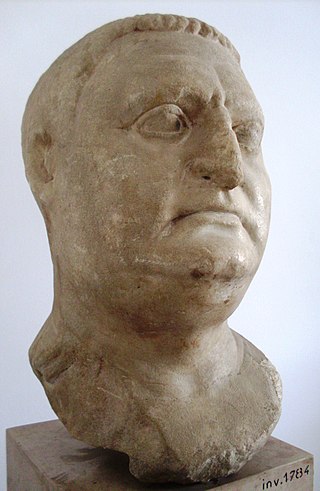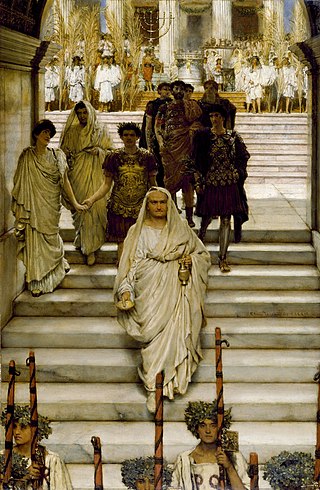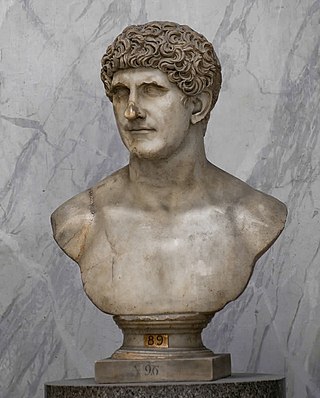In the Year of the Four Emperors
During the Year of the Four Emperors, Saturninus and his relative Gaius Dillius Aponianus initially supported Vitellius, to whom Saturninus wrote a letter reporting on the fomenting rebellion. [5] Later Saturninus switched his allegiance to Vespasian, and crossed the Alps to join Marcus Antonius Primus in northern Italy. [6] There, he tried to use the civil war as a pretext for killing a personal rival, his fellow officer Tettius Julianus. Julianus was well-liked by the soldiers, a partisan of Vespasian, and brother-in-law of Vespasian's finance minister, but nonetheless Saturninus accused him of secretly supporting Vitellius. [7] [8] Primus, who was anxious to obtain the supreme command, excited a mutiny of the soldiers against Saturninus, who before his change of allegiance had attempted to assassinate pro-Vespasian factions in his legion. Saturninus was compelled to flee the camp. [5]
Saturninus' fate afterwards is uncertain. He is known to have been proconsul of Asia, and some sources date this appointment to 73/74, [9] but Syme has pointed out some weaknesses in that argument and argued instead for a date of 67/68. [10] Based on Syme's proposed earlier date, and the fact he last appears in the records of the Arval Brethren January 69, [11] it is possible Saturninus died not long after taking flight.

Domitian was Roman emperor from 81 to 96. The son of Vespasian and the younger brother of Titus, his two predecessors on the throne, he was the last member of the Flavian dynasty. Described as "a ruthless but efficient autocrat", his authoritarian style of ruling put him at sharp odds with the Senate, whose powers he drastically curtailed.

Aulus Vitellius was Roman emperor for eight months, from 19 April to 20 December AD 69. Vitellius was proclaimed emperor following the quick succession of the previous emperors Galba and Otho, in a year of civil war known as the Year of the Four Emperors. Vitellius was the first to add the honorific cognomen Germanicus to his name instead of Caesar upon his accession. Like his direct predecessor, Otho, Vitellius attempted to rally public support to his cause by honoring and imitating Nero who remained widely popular in the empire.

The Year of the Four Emperors, AD 69, was the first civil war of the Roman Empire, during which four emperors ruled in succession: Galba, Otho, Vitellius, and Vespasian. It is considered an important interval, marking the transition from the Julio-Claudians, the first imperial dynasty, to the Flavian dynasty. The period witnessed several rebellions and claimants, with shifting allegiances and widespread turmoil in Rome and the provinces.

The Flavian dynasty ruled the Roman Empire between AD 69 and 96, encompassing the reigns of Vespasian (69–79), and his two sons Titus (79–81) and Domitian (81–96). The Flavians rose to power during the civil war of 69, known as the Year of the Four Emperors. After Galba and Otho died in quick succession, Vitellius became emperor in mid 69. His claim to the throne was quickly challenged by legions stationed in the Eastern provinces, who declared their commander Vespasian emperor in his place. The Second Battle of Bedriacum tilted the balance decisively in favour of the Flavian forces, who entered Rome on 20 December. The following day, the Roman Senate officially declared Vespasian emperor of the Roman Empire, thus commencing the Flavian dynasty. Although the dynasty proved to be short-lived, several significant historic, economic and military events took place during their reign.
Gaius Licinius Mucianus was a Roman general, statesman and writer. He is considered to have played a role behind the scenes in the elevation of Vespasian to the throne.
Gaius Sallustius Passienus Crispus was a prominent figure in the Roman Empire during the first century. He held the consulship twice, and was stepfather of the future emperor Nero.

De vita Caesarum, commonly known as The Twelve Caesars, is a set of twelve biographies of Julius Caesar and the first 11 emperors of the Roman Empire written by Gaius Suetonius Tranquillus. The group are: Julius Caesar, Augustus, Tiberius, Caligula, Claudius, Nero, Galba, Otho, Vitellius, Vespasian, Titus, Domitian.
Quintus Pomponius Secundus was a Roman aristocrat of the first century, and consul suffectus in AD 41 as the colleague of Gnaeus Sentius Saturninus. His brother was the poet and statesman Publius Pomponius Secundus, and their half-sister, Milonia Caesonia, was the second wife of the emperor Caligula.
Lucius Vitellius was a Roman senator who lived in the 1st century. He was the second son of Lucius Vitellius and Sextilia, and younger brother of emperor Aulus Vitellius. Lucius was suffect consul in the nundinium of July-December 48 with Gaius Vipstanus Messalla Gallus as his colleague.
Titus Flavius Sabinus was a Roman senator who was active in the first century AD. He was twice consul suffectus, first in the nundinium of April through June of 69 with his brother Gnaeus Arulenus Caelius Sabinus, and again in May and June of 72 as the colleague of Gaius Licinius Mucianus.
Cornelius Fuscus was a Roman general who fought campaigns under the Emperors of the Flavian dynasty. He first distinguished himself as one of Vespasian's most ardent supporters during the civil war of 69 AD, known as the Year of the Four Emperors. Vespasian's son Domitian employed Fuscus as prefect of the Praetorian Guard, a post he held from 81 until his death.
Lucius Salvius Otho Titianus was the elder brother of the Roman Emperor Otho. As a Roman senator, he was consul in the year 52 as the colleague of Faustus Cornelius Sulla Felix, and appointed consul as his brother's colleague for the period from Galba's murder to the end of February. Titianus was given the daily responsibilities of the emperor by Otho when Otho left Rome to halt the advance of Vitellius into Italy. Subsequently, Titianus was appointed generalissimo in charge of the war by Otho and was present at the First Battle of Bedriacum.
The gens Vitellia was a family of ancient Rome, which rose from obscurity in imperial times, and briefly held the Empire itself in AD 69. The first of this gens to obtain the consulship was Aulus Vitellius, uncle of the emperor Vitellius, in AD 32.

The gens Antonia was a Roman family of great antiquity, with both patrician and plebeian branches. The first of the gens to achieve prominence was Titus Antonius Merenda, one of the second group of Decemviri called, in 450 BC, to help draft what became the Law of the Twelve Tables. The most prominent member of the gens was Marcus Antonius.
Gaius Dillius Aponianus was a Roman senator and general, who played a role in the Year of Four Emperors. Aponianus ended up supporting Vespasian, and as a reward he was appointed suffect consul during the early years of that emperor.
Lucius Tettius Julianus was a Roman general who held a number of imperial appointments during the Flavian dynasty. He was suffect consul for the nundinium of May–June 83 with Terentius Strabo Erucius Homullus as his colleague.
Lucius Venuleius Montanus Apronianus was a Roman senator of the first century. He was suffect consul for the nundinium of January to April AD 92 with Qunintus Volusius Saturninus, replacing the emperor Domitian.

Lucius Calpurnius Piso was a Roman senator active in the first century AD. During the Year of Four Emperors he was governor of Africa and supported Vitellius. After the death of Vitellius he was killed by supporters of Vespasian.
Lucius Tampius Flavianus was a Roman senator who was consul twice, as a suffect consul. In his first consulship, whose date is no longer known, his colleague was Publius Fabius Firmanus. Flavianus stayed on the periphery of the civil war fought during the Year of the Four Emperors. Under the victor of the war, Vespasian, he served his second consulship, with Marcus Pompeius Silvanus Staberius Flavianus as colleague, in the third nundinium of the year 76.
Lucius Annius Vinicianus was a Roman senator during the Principate. He is best known for his involvement in the assassination of Caligula and a rebellion against Claudius.
![]() This article incorporates text from a publication now in the public domain : Smith, William (1870). "Saturninus, Aponius". In Smith, William (ed.). Dictionary of Greek and Roman Biography and Mythology . Vol. 3. p. 723.
This article incorporates text from a publication now in the public domain : Smith, William (1870). "Saturninus, Aponius". In Smith, William (ed.). Dictionary of Greek and Roman Biography and Mythology . Vol. 3. p. 723.





